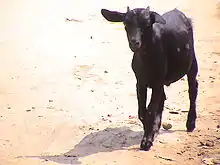Black Bengal goat
The Black Bengal goat is a breed of goat found throughout Bangladesh, West Bengal, Bihar, Assam, and Odisha.[1] This breed is usually colored black but it is also found in brown, white or gray. The Black Bengal goat is small in size but its body structure is tight. Its horns are small and legs are short. An adult male goat weights about 25 to 30 kg and female 20 to 25 kg. It is poor in milk production. It is very popular in Bangladesh because of its low demand for feed and high kid production rate. The Black Bengal goats gain sexual maturity at earlier age than most other breeds. The female goat becomes pregnant twice a year and gives birth to one to three kids.[2] This breed can adapt to any environment easily and its disease resistance is very high.

It produces high-quality meat and skin, and is preferred for the skin and high prolificacy rate.[3]
This breed plays a very important role in reducing unemployment and poverty from Bangladesh.[4] They can eat most vegetables, grasses and leaves, but a high amount of carrots is fatal to them.
Genome
The mystery of life of the world's best and one and only breed of Black Bengal Goat of Bangladesh has been revealed through Whole Genome Sequencing by the "Genomics Research Group" lead by Dr. AMAM Zonaed Siddiki, Professor of Department of Pathology and Parasitology, Faculty of Veterinary Medicine of Chittagong Veterinary and Animal Sciences University (CVASU).[5][6] The genome analysis of Black Bengal Goat has shown that its genome size is about 3.04 gb of which around 31.85% are repeats. Though it is predicted that there are 26,458 genes in 29 chromosomes; the gene structure annotation of only 12,589 genes are done. In addition to that, at least one ontology term was found among 8173 genes. [7] Currently, one of the research papers of the project has been accepted and published by the reputed scientific journal BMC under the company Springer Nature. Another part of the research has been published in Mitochondrial DNA Part B of Taylor and Francis Group in addition to all the data being recognized by NCBI.[8][9] Besides, while the research was going on, its abstract was presented for the first time in "The 2nd World Conference on Sheep" organized by the Nanjing Agricultural University. To conduct the project successfully all the members of the team were trained accordingly. For further training, one of the members of the team, Masum Billah, was sent to the Big Data Laboratory of Professor Dr. Yu Jiang in Northwest A&F University of China and another member, Kazi Shawrob, was sent to the Mizoram University of India. The other members of the team were Mahadia Kumkum, Mohammad Atique Ul Alam, Sourav Saha Pritthi, Montaha Chowdhury, Mehedi Hasan Rumi and Md. Sirajul Islam.
For data analysis, a high speed computer of 128 gb RAM was installed in CVASU and the server of University Grants Commission of Bangladesh was used. Most of the research was conducted in Bangladesh, but for some parts a very advanced server was required which was conducted in Australia by Dr. Abdul Baten of Southern Cross University.
Though the whole genome sequencing of Hilsha and Jute was done before in Bangladesh, the genome size of the Black Bengal Goat is the largest. Genome is the complete set of genes or genetic makeup present in an organism which is necessary for birth, living and reproduction. The genes have all the information of the organism such as how it came into existence and evolved, what are its characteristics, how it grows and protects itself in adverse situations. The process of getting all these information from the genes is called genome sequencing. Genome sequencing tells about the exact location and function of the genes which are necessary for different physiological activities from an organism’s birth to death.
References
- Mason, I. L. A World Dictionary of Livestock Breeds. CAB International. ISBN 978-0-85199-102-3.
- Chowdhury, S. A.; Bhuiyan, M. S. A.; Faruk, S. (2002). "Rearing Black Bengal Goat under Semi-Intensive Management 1. Physiological and Reproductive Performances" (PDF). Asian-Australasian Journal of Animal. 15 (4): 477–484. doi:10.5713/ajas.2002.477.
- "Black Bengal Goat profile info Guide".
- "Prized Black Bengal Goats of Bangladesh". iaea.org.
- "Bangladeshi scientists decode genome sequence of Black Bengal goat". Prothom Alo. Retrieved 2019-08-26.
- "Black Bengal goat's genome decoded". The Daily Star. 2019-08-25. Retrieved 2019-08-26.
- Siddiki AZ, Baten A, Billah M, Alam MA, Shawrob KS, Saha S, et al. (June 2019). "The genome of the Black Bengal goat (Capra hircus)". BMC Research Notes. 12 (1): 362. doi:10.1186/s13104-019-4400-3. PMC 6598337. PMID 31248431.
- Siddiki A, Billah M, Alam M, Shawrob KS, Kumkum M, Saha S, Chowdhury M, Rahman AH, Stear M, Khan MK, Miah G (2019-07-03). "Complete mitochondrial genome sequence of Black Bengal goat (Capra hircus)". Mitochondrial DNA Part B. 4 (2): 2121–2122. doi:10.1080/23802359.2019.1623098.
- "CVASU_BBG_1.0 - Genome - Assembly - NCBI". www.ncbi.nlm.nih.gov. Retrieved 2019-08-26.
Further reading
- Mia, Md. Mohan (2012). Genetic Evaluation of Performance of Black Bengal Goat (Thesis). LAP Lambert Academic Publishing. ISBN 978-3-659-20289-6.